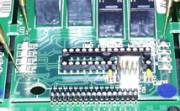SMT or Surface- Mount technology helps in production of electronic circuits. The components are placed directly onto the surface of PCBs or printed circuit boards in this type of technology. The electronic devices which are made by this method are called surface-mount device or SMD.
Surface Mount technology has emerged as a popular choice and has replaced the through-hole technology within the industrial structure. In the through-hole technology, the fitting components are constructed with wire leads put into the holes of the circuit board. SMT component is preferred over the through-hole substitute, since it is smaller in size. This is so because it has smaller or no leads in it. The pins or leads may be of various styles, viz. terminations on the body of the component, flat contacts, or a matrix of solder balls better known as ball grid array.
As mentioned above, BGA or ball grid array is the very packaging type used in surface-mount devices. These are used basically for integrated circuits. It provides more interconnection pins than a flat package or dual-in line. Instead of the perimeter, the whole surface of the bottom can be used in these types of devices. It also provides shorter leads than the ones in perimeter type, thus leading to a better performance with high speed. Soldering of these devices require precision. So, automated processes are used.
Advantages of BGA packaging:
• provides high density
• provides less thermal resistance between the PCB and package
• the leads has low inductance
The SMT soldering process should be done matched with the design and specification of the device. X-ray inspection should be used to test the solder joint quality. 3D-X-ray inspection is done to detect the problems of BGA assembly on SMT soldering.
To know more about Surface Mount PCB assembly logon to http://www.dferrantielectronics.co.uk/.





